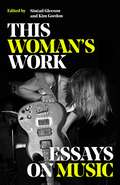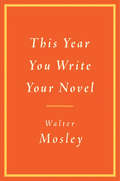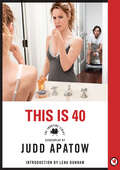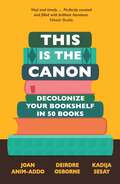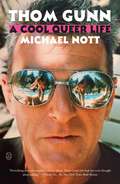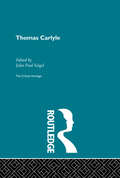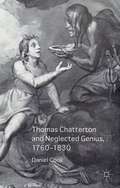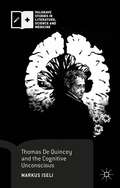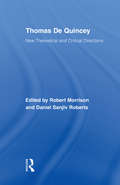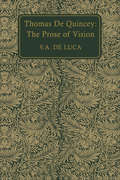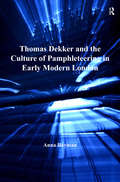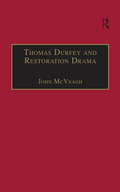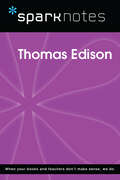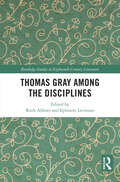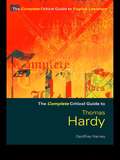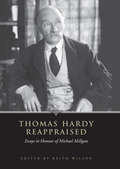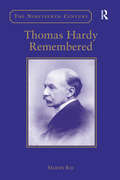- Table View
- List View
This Will Not Be Generative (Elements in Feminism and Contemporary Critical Theory)
by Dixa Ramírez-D'OleoThis Will Not Be Generative attends to the semiotics of ecological writings via Caribbean literary studies and black critical theory. Closely reading texts by Donna Haraway, Monique Allewaert, and Lisa Wells, it exposes how the language of tentacles and tendrils, an assumptive 'we,' and redemptive sympathy or 'care' disguises extraction from black people and blackness. This often speculative rhetoric, abetted by fantasies of white communion with indigenous groups, contrasts with the horror semiotics of the films Get Out (2017) and Midsommar (2019), which unmask the antagonistic relationship between white survival 'at the end of the world' and blackness as compost.
This Woman's Work: Essays on Music
by VariousThis Woman's Work: Essays on Music is edited by Kim Gordon and Sinéad Gleeson and features contributors Anne Enright, Fatima Bhutto, Jenn Pelly, Rachel Kushner, Juliana Huxtable, Leslie Jamison, Liz Pelly, Maggie Nelson, Margo Jefferson, Megan Jasper, Ottessa Moshfegh, Simone White, Yiyun Li and Zakia Sewell.Published to challenge the historic narrative of music and music writing being written by men, for men, This Woman's Work seeks to confront the male dominance and sexism that have been hard-coded in the canons of music, literature, and film and has forced women to fight pigeon-holing or being side-lined by carving out their own space. Women have to speak up, to shout louder to tell their story - like the auteurs and ground-breakers featured in this collection, including: Anne Enright on Laurie Anderson; Megan Jasper on her ground-breaking work with Sub Pop; Margo Jefferson on Bud Powell and Ella Fitzgerald; and Fatima Bhutto on music and dictatorship.This Woman's Work also features writing on the experimentalists, women who blended music and activism, the genre-breakers, the vocal auteurs; stories of lost homelands and friends; of propaganda and dictatorships, the women of folk and country, the racialised tropes of jazz, the music of Trap and Carriacou; of mixtapes and violin lessons.
This Year You Write Your Novel
by Walter MosleyNo more excuses. "Let the lawn get shaggy and the paint peel from the walls," bestselling novelist Walter Mosley advises. Anyone can write a novel now, and in this essential book of tips, practical advice, and wisdom, Walter Mosley promises that the writer-in-waiting can finish it in one year. Intended as both inspiration and instruction, the book provides the tools to turn out a first draft painlessly and then revise it into something finer. Mosley tells how to: *Create a daily writing regimen to fit any writer's needs--and how to stick to it. *Determine the narrative voice that's right for every writer's style. *Get past those first challenging sentences and into the heart of a story.
This is 40: The Shooting Script (Shooting Script)
by Judd ApatowFive years after Judd Apatow introduced us to Pete and Debbie in Knocked Up, Paul Rudd and Leslie Mann reprise their roles as the couple in the writer/director's This Is 40, a comedic look at the everyday life of an American family. What emerges is a portrait of the challenges and rewards of marriage and parenthood: sex and romance, career triumphs and financial hardships, aging parents and maturing children and everything in between. This Is 40 captures what it takes for a family to flourish in the middle of a lifetime together, rendered with the unique intimacy of a filmmaker collaborating with his own wife and children.The Newmarket Shooting Script Book includes: An introduction by writer/actor Lena Dunham written especially for this edition Judd Apatow's answers to "Five Obvious Questions" and an afterword on his writing/directing process The complete screenplay 35 color photographs Complete cast and crew credits
This is Writing: A Conceptual Guide to College Composition (Third Edition)
by J. D. IsipMany people consider writing to be a skill. A skill is something you can learn and perform. A skill can also be improved upon. If we think of writing, we might reflect on our own learning of words--how to put the letters together to form them. Then, of course, we would string those words into sentences and the sentences into paragraphs. In this way, one certainly would not argue against the concept of writing as a skill to be learned and improved upon. In "This is Writing: A Conceptual Guide to College Composition", J. D. Isip explains how thinking of a subject conceptually is to hold it out in front of you and evaluate it from several different angles, to apply multiple mental lenses and filters, and to draw conclusions and evaluate those conclusions.
This is the Canon: Decolonize Your Bookshelves in 50 Books
by Deirdre Osborne Joan Anim-Addo Kadija Sesay George'A vital and timely introduction to some of the best books I've ever read. Perfectly curated and filled with brilliant literature'Nikesh Shukla'The ultimate introduction to post-colonial literature for those who want to understand the classics and the pioneers in this exciting area of books'Symeon BrownThese are the books you should read. This is the canon.Joan Anim-Addo, Deirdre Osborne and Kadija Sesay have curated a decolonized reading list that celebrates the wide and diverse experiences of people from around the world, of all backgrounds and all races. It disrupts the all-too-often white-dominated 'required reading' collections that have become the accepted norm and highlights powerful voices and cultural perspectives that demand a place on our shelves. From literary giants such as Toni Morrison and Chinua Achebe to less well known (but equally vital) writers such as Caribbean novelist Earl Lovelace or Indigenous Australian author Tony Birch, the novels recommended here are in turn haunting and lyrical; innovative and inspiring; edgy and poignant.The power of great fiction is that readers have the opportunity to discover new worlds and encounter other beliefs and opinions. This is the Canon offers a rich and multifaceted perspective on our past, present and future which deserves to be read by all bibliophiles - whether they are book club members or solitary readers, self-educators or teachers.
This is the Canon: Decolonize Your Bookshelves in 50 Books
by Deirdre Osborne Joan Anim-Addo Kadija Sesay George'A vital and timely introduction to some of the best books I've ever read. Perfectly curated and filled with brilliant literature'Nikesh Shukla'The ultimate introduction to post-colonial literature for those who want to understand the classics and the pioneers in this exciting area of books'Symeon BrownThese are the books you should read. This is the canon.Joan Anim-Addo, Deirdre Osborne and Kadija Sesay have curated a decolonized reading list that celebrates the wide and diverse experiences of people from around the world, of all backgrounds and all races. It disrupts the all-too-often white-dominated 'required reading' collections that have become the accepted norm and highlights powerful voices and cultural perspectives that demand a place on our shelves. From literary giants such as Toni Morrison and Chinua Achebe to less well known (but equally vital) writers such as Caribbean novelist Earl Lovelace or Indigenous Australian author Tony Birch, the novels recommended here are in turn haunting and lyrical; innovative and inspiring; edgy and poignant.The power of great fiction is that readers have the opportunity to discover new worlds and encounter other beliefs and opinions. This is the Canon offers a rich and multifaceted perspective on our past, present and future which deserves to be read by all bibliophiles - whether they are book club members or solitary readers, self-educators or teachers.
Tholkappiyam Ezhuthathikaram Ilampooranam: தொல்காப்பியம் எழுத்ததிகாரம் இளம்பூரணம்
by Directorate of Distance Education Alagappa University Karaikudiஇந்த ஆவணம் தொல்காப்பியம் - எழுத்ததிகாரம் பற்றிய முழுமையான ஆய்வுக் கையேடாகும், இது டாக்டர் எம். சிதம்பரத்தின் உரையுடன் வடிவமைக்கப்பட்டுள்ளது. தமிழின் இலக்கணக் கொள்கைகளை விளக்குவதில் இது முக்கியமானதாக உள்ளது, குறிப்பாக எழுத்துக்கள் மற்றும் ஒலிகளின் தோற்றம், செயல்பாடு மற்றும் மாற்றங்களைப் பற்றியும், அவற்றின் சொற்கள் மற்றும் வாக்கியங்களை அமைப்பதில் காணப்படும் பயன்பாடுகளையும் விவரிக்கிறது. இதில் மொழிமரபுகள், ஒலியியல், உருபியல் மற்றும் சொல்லமைப்பு ஆகிய பிரிவுகள் அடங்கியுள்ளன. தமிழின் அமைப்பு மற்றும் ஒலியியல் விதிகளின் நுட்பங்களை விளக்குவதோடு, மொழியின் கலாசார மற்றும் வரலாற்றுச் சிறப்பையும் அலசுகிறது. தொலைநிலைக் கல்வி இயக்கம் மூலம் வழங்கப்படும் எம்.ஏ. தமிழ் பாடத்திட்டத்தின் ஒரு பகுதியாக, இந்த கையேடு தமிழின் இலக்கண வளங்களை ஆராய, பகுப்பாய்வு திறன்களை மேம்படுத்த மற்றும் தமிழின் இலக்கணச் செழுமையைப் பற்றிய ஆழ்ந்த புரிதலை உருவாக்க வடிவமைக்கப்பட்டுள்ளது.
Thom Gunn: A Cool Queer Life
by Michael NottA no-holds-barred biography of the great poet and sexual rebel, who could “give the dead a voice, make them sing” (Hilton Als, The New Yorker). Thom Gunn was not a confessional poet, and he withheld much, but inseparable from his rigorous, formal poetry was a ravenous, acute experience of life and death. Raised in Kent, England, and educated at Cambridge, Gunn found a home in San Francisco, where he documented the city’s queerness, the hippie mentality (and drug use) of the sixties, and the tragedy and catastrophic impact of the AIDS crisis in the eighties and beyond. As Jeremy Lybarger wrote in The New Republic, the author of Moly and The Man with Night Sweats was “an agile poet who renovated tradition to accommodate the rude litter of modernity.” Thom Gunn: A Cool Queer Life chronicles, for the first time, the largely undocumented life of this revolutionary poet. Michael Nott, a coeditor of The Letters of Thom Gunn, draws on letters, diaries, notebooks, interviews, and Gunn’s poetry to create a portrait as vital as the man himself. Nott writes with insight and intimacy about the great sweep of Gunn’s life: his traditional childhood in England; his mother’s suicide; the mind-opening education he received at Cambridge, reading Shakespeare and John Donne; his decades in San Francisco and with his life partner, Mike Kitay; and his visceral experience of sex, drugs, and loss. Thom Gunn: A Cool Queer Life is a long-awaited, landmark study of one of England and America’s most innovative poets.
Thomas Aquinas (SparkNotes Philosophy Guide)
by SparkNotesThomas Aquinas (SparkNotes Philosophy Guide) Making the reading experience fun! SparkNotes Philosophy Guides are one-stop guides to the great works of philosophy–masterpieces that stand at the foundations of Western thought. Inside each Philosophy Guide you&’ll find insightful overviews of great philosophical works of the Western world.
Thomas Burke's Dark Chinoiserie: Limehouse Nights and the Queer Spell of Chinatown
by Anne Veronica WitchardFocusing on Thomas Burke's bestselling collection of short stories, Limehouse Nights (1916), this book contextualises the burgeoning cult of Chinatown in turn-of-the-century London. London's 'Chinese Quarter' owed its notoriety to the Yellow Perilism that circulated in Britain at the fin-de-siècle, a demonology of race and vice masked by outward concerns about degenerative metropolitan blight and imperial decline. Anne Witchard's interdisciplinary approach enables her to displace the boundaries that have marked Chinese studies, literary studies, critiques of Orientalism and empire, gender studies, and diasporic research, as she reassesses this critical moment in London's history. In doing so, she brings attention to Burke's hold on popular and critical audiences on both sides of the Atlantic. A much-admired and successful author in his time, Burke in his Chinatown stories destabilizes social orthodoxies in highly complex and contradictory ways. For example, his writing was formative in establishing the 'queer spell' that the very mention of Limehouse would exert on the public imagination, and circulating libraries responded to Burke's portrayal of a hybrid East End where young Cockney girls eat Chow Mein with chopsticks in the local cafés and blithely gamble their housekeeping money at Fan Tan by banning Limehouse Nights. Witchard's book forces us to rethink Burke's influence and shows that China and chinoiserie served as mirrors that reveal the cultural disquietudes of western art and culture.
Thomas Carlyle: The Critical Heritage (The\critical Heritage Ser.)
by Jules Paul SeigelThe Critical Heritage gathers together a large body of critical sources on major figures in liteature. Each volume presents contemporary responses on a writer's work, enabling student and researcher to read the material themselves.
Thomas Chatterton and Neglected Genius, 1760–1830
by Daniel CookLong before Wordsworth etherealized him as 'the marvellous Boy / The sleepless Soul that perished in its pride', Thomas Chatterton was touted as the 'second Shakespeare' by eighteenth-century Shakespeareans, ranked among the leading British poets by prominent literary critics, and likened to the fashionable modern prose stylists Macpherson, Sterne, and Smollett. His pseudo-medieval Rowley poems, in particular, engendered a renewed fascination with ancient English literature. With Chatterton as its case study, this book offers new insights into the formation and development of literary scholarship in the period, from the periodical press to the public lecture, from the review to the anthology, from textual to biographical criticism. Cook demonstrates that, while major scholars found Chatterton to be a pertinent subject for multiple literary debates in the eighteenth century, by the end of the Romantic period he had become, and still remains, an unsettling model of hubristic genius.
Thomas De Quincey and the Cognitive Unconscious (Palgrave Studies in Literature, Science and Medicine)
by Markus IseliThis book examines Thomas De Quincey's notion of the unconscious in the light of modern cognitive science and nineteenth-century science. It challenges Freudian theories as the default methodology in order to understand De Quincey's oeuvre and the unconscious in literature more generally.
Thomas De Quincey and the Cognitive Unconscious (Palgrave Studies in Literature, Science and Medicine)
by Markus IseliThis book examines Thomas De Quincey's notion of the unconscious in the light of modern cognitive science and nineteenth-century science. It challenges Freudian theories as the default methodology in order to understand De Quincey's oeuvre and the unconscious in literature more generally.
Thomas De Quincey: New Theoretical and Critical Directions (Routledge Studies in Romanticism)
by Robert Morrison Daniel Sanjiv RobertsThe ongoing critical fascination with Thomas De Quincey and the burgeoning recognition of the centrality of his writings to the Romantic age and beyond necessitates a critical examination of De Quincey. In this spirit, ten of the top De Quincey scholars in the world have come together in this volume to engage directly with the immense amount of new information to be published on De Quincey in the past two decades. The book features wide-ranging and incisive assessments of De Quincey as essayist, addict, economist, subversive, biographer, autobiographer, aesthete, innovator, hedonist, and much else.
Thomas De Quincey: The Prose of Vision
by V.A. De LucaThomas De Quincey: The Prose of Vision is the first full-length critical study of De Quincey's imaginative writings. Considering these writings as a 'prose of vision' transcending their origins in magazine journalism, the author stresses their relationship to the Romantic traditions of imaginative vision and inward quest. He traces continuing themes and their transformations throughout De Quincey's career, and he offers sustained critical readings of De Quincey's major works. Professor De Luca discusses, in chronological sequence, the original version of Confessions of an English Opium-Eater, in which De Quincey traces his passage from innocence to experience; Gothic tales and essays on murder, which reveal a fascination with the concept of power; and the major works of De Quincey's later years, including Suspiria de Profundis, The English Mail-Coach, and the revised Confessions, which show the richest development of his interest in vision and in self-exploration. The book concludes with a discussion of the equivocal implications in De Quincey's three late major works and relates these implications to the equivocal tendencies in the Romantic tradition itself – its uneasy yearning for transcendence and its courageous commitment to the flow of ordinary experience. This study, which makes a significant contribution to an understanding of De Quincey's works, will be of particular interest to students of Romanticism.
Thomas Dekker and the Culture of Pamphleteering in Early Modern London
by Anna BaymanThomas Dekker (c.1572-1632) was a prolific playwright and pamphleteer chiefly remembered for his vivid and witty portrayals of everyday London life. This book uses Dekker’s prose pamphlets (published between 1613 and 1628) as a way in to a crucial and relatively neglected period of the history of pamphleteering. Under James I, after the aggressive Elizabethan exploitation of the new media, pamphleteers carved out a discursive space in which claims about truth and authority could be deconstructed. Avoiding the dangerous polemic employed by the Marprelate pamphleteers, they utilised playful, deliberately ambiguous language that drew readers’ attention to their own literary devices and games. Dekker shows pamphlets to be unstable and roguish, and the nakedly commercial imperatives of the book trade to be central to the world of Jacobean cheap print, as he introduces us to a world in which overlapping and competing discourses jostled for position in London’s streets, markets and pulpits. Contributing to the history of print and to the history of Jacobean London, this book also provides an appraisal of the often misunderstood prose works of an author who deserves more attention, especially from historians, than he has so far received. Critics are slowly becoming aware that Dekker was not the straightforward, simple hack writer of so many accounts; his works are complex and richly reward study in their own right as well as in the context of his more famous predecessors and contemporaries. As such this book will further contribute to a post-revisionist historiography of political consciousness and print cultures under the early Stuarts, as well as illuminate the career of a neglected writer.
Thomas Durfey and Restoration Drama: The Work of a Forgotten Writer (Studies in Early Modern English Literature)
by John McVeaghThough once a favourite of no fewer than four English monarchs, Restoration playwright Thomas Durfey has long been neglected by scholars. In his own day he had a lowly reputation in the world of polite letters - before his death his plays had more or less ceased to be produced; his 'serious' poems had died long before that, and even his songs were soon thought of as common property or 'folk' songs. In this new study, author John McVeagh re-examines Durfey's literary output, finding merit and interest where it has long been presumed that none existed, and restoring Durfey to his proper place in late 17th- and early 18th-century literature. Durfey's creative lifetime spanned the entire Restoration period and continued into and beyond the reign of Queen Anne. McVeagh's book studies his continuing ability to adapt to shifts in taste, fashion and personnel in the world of the theatre. It examines in detail his numerous experiments in new kinds of dramatic writing, both responding to and influencing the conditions of theatrical and artistic production. Among the topics covered are Durfey's attempts to feminize Restoration comedy, his political satires in drama in the late Stuart years, his anticipations of sentimental comedy, his search for a new language for lower class tragedy, and his musical-dramatic experimentations in the 1680s and 1690s, focusing particularly on his collaborative work with Matthew Locke, Samuel Ackroyde, John Eccles, Daniel and Henry Purcell and other composers. In addition, the author discusses Durfey's numerous satiric, narrative and other poems, and relates his writings to their social, political and cultural contexts. The book includes a performance record, listing the plays by performance date. The record includes such information, if known, as: where it was performed; by what company; cast list; to whom it was dedicated; a brief description of the prologue and epilogue; when it was published; what music it contained; and details of any revivals.
Thomas Edison (SparkNotes Biography Guide)
by SparkNotesThomas Edison (SparkNotes Biography Guide) Making the reading experience fun! SparkNotes Biography Guides examine the lives of historical luminaries, from Alexander the Great to Virginia Woolf. Each biography guide includes:An examination of the historical context in which the person lived A summary of the person&’s life and achievements A glossary of important terms, people, and events An in-depth look at the key epochs in the person&’s career Study questions and essay topics A review test Suggestions for further reading Whether you&’re a student of history or just a student cramming for a history exam, SparkNotes Biography guides are a reliable, thorough, and readable resource.
Thomas Gray among the Disciplines (Routledge Studies in Eighteenth-Century Literature)
by Ruth Abbott and Ephraim LevinsonThroughout the 250 years that have passed since Thomas Gray’s death, he has primarily been celebrated as a poet. This makes sense because, although he published relatively little verse, he published less – indeed, precisely nothing – of his abundant polymathic writing in other fields. His place within the history of scholarship has therefore been obscured. Like many eighteenth-century antiquaries, however, he shared his learning through correspondence and manuscript circulation and thereby influenced intellectual as well as literary life. This book explores Gray’s scholarship within the changing norms of eighteenth-century disciplines, at once locating him within histories of specialisation and examining the ways in which he challenges their narratives. Scholars from across the humanities reveal his methods and global interests and analyse many newly uncovered manuscripts. Offering fresh understanding of broader fields through focused investigation of Gray’s multidisciplinary writings, the book will appeal to scholars of eighteenth-century literary, intellectual, and scientific history.
Thomas Hardy
by Mark FordBecause Thomas Hardy's poetry and fiction are so closely associated with Wessex, it is easy to forget that he was, in his own words, half a Londoner, moving between country and capital throughout his life. This self-division, Mark Ford says, can be traced not only in works explicitly set in London but in his most regionally circumscribed novels.
Thomas Hardy (Routledge Guides to Literature)
by Geoffrey HarveyThomas Hardy was the foremost novelist of his time, as well as an established poet. Author of Jude the Obscure and Far from the Madding Crowd, Hardy reflected in his works the dynamics of social, intellectual and aesthetic change in nineteenth-century England.This guide provides students with a lucid introduction to Hardy's life and works and the basis for a sound comprehension of his work, including: the major aspects of Hardy's life in the context of contemporary culture a detailed commentary on Hardy's most important work and a critical map of Hardy's complete writing an outline of the vast body of criticism that has built up around Hardy's work with examples of recent critical debate. Exposition and guide, this volume enables readers to form their own readings of one of the most important writers of the nineteenth century.
Thomas Hardy Reappraised
by Keith WilsonAs a writer who achieved major eminence in both fiction and poetry and whose engagement with these genres encompassed the period of transition from Victorianism to Modernism, Thomas Hardy (1840-1928) enjoys a unique position in English Literary History. Michael Millgate, University Professor of English Emeritus at the University of Toronto is widely recognized as the world's foremost Thomas Hardy scholar. His contributions to the study of Hardy over more than three decades include his recently 'revisited' biography, the seven volume edition of Hardy's collected letters, and the influential critical study Thomas Hardy: His Career as a Novelist.In Thomas Hardy Reappraised, editor Keith Wilson pays tribute to Millgate's many contributions to Hardy studies by bringing together new work by fifteen of the world's most eminent Hardy scholars. These essays address questions of biblical and literary allusiveness, cultural, historical, and philosophical context, narrative and poetic theory and practice, as well as Hardy's place in the modern world and his influence on younger writers. Together, the contributors offer one of the most significant reappraisals of Hardy's work to have appeared since Michael Millgate helped to transform Hardy studies. They offer graphic testimony to Hardy's enduring popularity and importance.Contributors:Pamela DalzielMary RimmerDennis TaylorBarbara HardyU.C. KnoepflmacherMarjorie GarsonRuth Bernard YeazellSimon GatrellJ. Hillis MillerGeorge LevineJeremy V. SteeleWilliam W. MorganSamuel HynesNorman PageW. J. Keith
Thomas Hardy Remembered (The Nineteenth Century Series)
by Martin RayThomas Hardy Remembered assembles some 150 annotated interviews and recollections of Hardy, most of which are being reprinted for the first time. They range from close personal reflections by old friends such as Sir George Douglas, J.M. Barrie, and Edmund Gosse, to fleeting glimpses by strangers who saw Hardy at a London party or at his club. Martin Ray has selected items having the greatest literary or biographical significance, and annotated them with meticulous accuracy and a keen eye for the telling detail. As a result, the volume will be an invaluable resource to scholars who are interested not only in what concerned Hardy personally and professionally, but also in how he was perceived by others. Having these items collected in one volume reveals Hardy's contemporaneous opinions about his own writings and also makes it possible to trace the marked recurrence, over time, of certain preoccupations: ancient families, Hardy's hostility to reviewers, architecture, Roman relics, Wessex folklore and dialect, animal welfare, Napoleon, and hangings. With regard to his literary career, a portrait emerges of Hardy as the scrupulous professional, properly aware of his commercial rights, while at the same time appearing, to some who met him, unconscious of his own genius.

